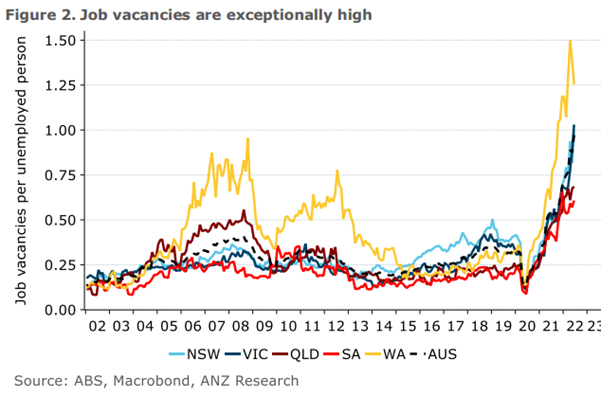-
ANZ Research think the Reserve Bank of Australia (RBA) will take the cash rate target to a restrictive setting of above 3 per cent by late 2022, more than 12 months earlier than previously forecast. For now, ANZ Research has the cash rate remaining at 3.35 per cent through 2023 and 2024.
The June labour market data were much stronger than expected with spectacular employment growth and the unemployment rate dropping to 3.5 per cent. This is the lowest unemployment rate since 1974.
"ANZ Research does think moves of more than 50 basis points in August or September are a very real possibility, while not the central case.”
What’s more, job ads and vacancies are at extremely high levels. There were almost 500,000 vacancies in May, a record high rate of 3.4 per cent as a share of the labour force.
{CF_IMAGE}
The large stock of vacancies suggests it will take a considerable slowdown in the economy for underutilisation not to fall further. ANZ Research’s longstanding forecast has been for unemployment to drop to 3.3 per cent in the later part of 2022. The risks to this forecast look to be weighted to the downside, even with somewhat faster rate hikes than previously. An unemployment rate with a 2-handle - 2+ per cent - is not out of the question.
{CF_IMAGE}
As to how the RBA gets to a restrictive setting, continued 50 basis point moves until November seem most likely. The RBA will want confirmation it is not moving well beyond neutral so will take advantage of its more frequent meetings by not jumping too far at any one time.
But ANZ Research does think moves of more than 50 basis points in August or September are a very real possibility although not the central case. This could be a move of 75 basis points or even 65 basis points if the RBA wanted to “round” the cash rate target to 0.25 per cent.
The faster move to a restrictive rate setting will bring forward the point at which the economy slows below trend. It also suggests house prices will fall by more than the 15 per cent or so ANZ Research currently anticipates to the end of 2023.
But it doesn’t necessarily mean a hard landing for the economy. A cash rate of 3.35 per cent implies household interest payments as a percentage of household income peak below the level reached in 2008.
Importantly, ANZ Research expect wages growth to accelerate over the course of this year and 2023, despite the faster pace of rate hikes (which are, remember, largely due to the tighter than expected labour market). What’s more, ANZ Research thinks wages growth will prove quite persistent even as the economy slows. This will keep household consumption from slowing too sharply (though it will slow as rates rise), as will the large pool of savings and the tax cuts set for 2024.
This suggests a rapid shift to rate cuts is unlikely unless there is a much sharper than expected global slowdown and/or ANZ Research’s estimate the neutral cash rate is in the 2s proves to be misplaced.
Still, the downside risks to the economy are significantly increased by the faster move to a restrictive cash rate setting. ANZ Research will monitor the incoming data closely for signs the economy is slowing faster than expected.
David Plank is Head of Australian Economics at ANZ
The views and opinions expressed in this communication are those of the author and may not necessarily state or reflect those of ANZ.
-
-
anzcomau:Bluenotes/global-economy,anzcomau:Bluenotes/Housing
The cash rate’s balancing act
2022-07-20
/content/dam/anzcomau/bluenotes/images/articles/2022/July/RatesUpdate_thumb.jpg
EDITOR'S PICKS
-
Will rising interest rates slow the growth of house prices in Australia? New data show the dream of home ownership may still be out of reach for many.
13 May 2022 -
There is a lot of focus on inflation and cash rates in Australia today – and there will be more. But what happens when they move and how does it impact the economy?
2 May 2022


